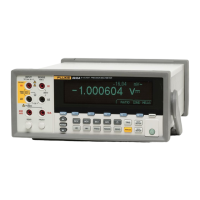8845A/8846A
Programmers Manual
24
Voltage Overload
2
0
= 1 2
8
= 256
2
1
= 2 2
9
= 512
2
2
= 4 2
10
= 1024
2
3
= 8 2
11
= 2048
2
4
= 16 2
12
= 4096
2
5
= 32 2
13
= 8192
2
6
= 64 2
14
= 16384
2
7
= 128 2
15
= 32768
Questionable Data Binary Wieghts
Event Register Enable Register
STAT:QUES:EVEN? STAT:QUES:ENAB <value>
STAT:QUES:ENAB?
"OR"
0
Current Overload1
Not Used
Not Used
Not Used
Not Used
Not Used
Not Used
Not Used
Ohms Overload
Not Used
9
Limit Test Fail LO11
Limit Test Fail HI12
13
Remote Mode
15
Not Used
Not Used
Not Used
Operation Complete
Standard Event
Event Register Enable Register
*ESR? *ESE <value>
*ESE?
"OR"
0
Not Used
Query Error2
Device Error3
Execution Error4
5
Command Error
7
Not Used
Power On
Not Used
Status Byte
Output Buffer
Summary Register Enable Register
Serial Poll (SPOLL)
*STB?
*SRE <value>
*SRE?
"OR"
0
Not Used
Not Used
Questionable Data
3
Message Available
4
5
Standard Event
7
6
Request Service
Not Used
caw01f.eps
Figure 3. Overview of Status Data Structure (8845A/8846A and Fluke 45)
Standard Event Status and Standard Event Status Enable Registers
The Standard Event Status Register (ESR) assigns events to specific bits (see Figure 3
and Table 5). When a bit in the ESR is set (for example, 1), the event that corresponds to
that bit has occurred since the register was last read or cleared. For example, if bit 3
(DDE) is set to 1, a device-dependent error has occurred.
The Standard Event Status Enable Register (ESE) is a mask register that allows the host
to enable or disable (mask) each bit in the ESR. When a bit in the ESE is 1, the
corresponding bit in the ESR is enabled. When any enabled bit in the ESR changes from
O to 1, the Standard Event bit in the Status Byte Register also goes to 1. When the ESR is
read (using the *ESR? command) or cleared (using the *CLS command), the Standard
Event bit in the Status Byte Register returns to 0.

